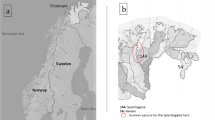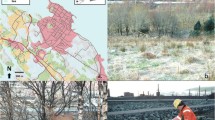Abstract
The increasing number of sheep (Ovis aries) in northern Finland, often alternately corralled with winter-fed reindeer (Rangifer tarandus tarandus), creates potential for cross-infection of gastrointestinal nematodes. The aim of this study was to elucidate this possibility with 43 animals. Eleven reindeer and 8 sheep had shared a corral by turns, reindeer during winters, and sheep in summers. Another 12 reindeer had no known contact with sheep. Twelve sheep had no close contact to other ruminants. Both reindeer groups were free-ranging during summers. During slaughter in September to November, 2003, abomasa and parts of intestines were collected. Gastrointestinal nematodes were counted and identified. The species found were the following: in reindeer, Ostertagia gruehneri/Ostertagia arctica, Mazamastrongylus dagestanica, Nematodirus tarandi, Nematodirella longissimespiculata and Bunostomum trigonocephalum; in sheep, Teladorsagia circumcincta/Teladorsagia trifurcata, O. gruehneri/O. arctica, Nematodirus filicollis and N. spathiger. In the sheep sharing corral with reindeer, the only abomasal nematode species found was O. gruehneri, a reindeer parasite. The generation interval of O. gruehneri in Finnish reindeer appears to be shorter than in Canadian Arctic caribou, where complete larval inhibition leading to only one generation yearly has been reported.
Similar content being viewed by others
References
Barth D, Visser M (1991) Magen-Darmnematoden des Rindes. [Bovine gastrointestinal nematodes]. Ferdinand Enke Verlag, Stuttgart, In German
Borgsteede FHM (1981) Experimental cross-infections with gastrointestinal nematodes of sheep and cattle. Z Parasitenkd 65:1–10
Bye K, Halvorsen O (1983) Abomasal nematodes of the Svalbard reindeer (Rangifer tarandus platyrhynchus Vrolik). J Wildl Dis 19:101–103
Bye K (1987) Abomasal nematodes from three Norwegian wild reindeer populations. Can J Zool 65:677–680
Bye K, Halvorsen O, Nilssen K (1987) Immigration and regional distribution of abomasal nematodes of Svalbard reindeer. J Biogeogr 14:451–458
Dallas JF, Irvine RJ, Halvorsen O (2000) DNA evidence that Ostertagia gruehneri and Ostertagia arctica (Nematoda: Ostertagiinae) in reindeer from Norway and Svalbard are conspecific. Intl J Parasitol 30:655–658
Drozdz J (1965) Studies on helminths and helminthiases in Cervidae. I. Revision of the subfamily Ostertagiinae Sarwar, 1956 and an attempt to explain the phylogenesis of its representatives. Acta Paras Polon 13:445–481
Fruetel M, Lankester MW (1989) Gastrointestinal helminths of woodland and barren ground caribou (Rangifer tarandus) in Canada, with keys to species. Can J Zool 67:2253–2269
Georgi JR (1985) Parasitology for veterinarians, 4th edn. W. B. Saunders Company, Philadelphia
Guðmunsdóttir B (2006) Sníkjudýr í hreindýrum á Íslandi. Parasites of reindeer (Rangifer tarandus) in Iceland. Master thesis, Faculty of Medicine, University of Iceland, Reykjavik. (In Icelandic)
Halvorsen O, Bye K (1999) Parasites, biodiversity, and population dynamics in an ecosystem in the high Arctic. Vet Parasitol 84:205–227
Halvorsen O, Stien A, Irvine J, Langvatn R, Albon S (1999) Evidence for continued transmission of parasitic nematodes in reindeer during the Arctic winter. Int J Parasitol 29:567–579
Hansen J, Perry B (1994) The epidemiology, diagnosis and control of helminth parasites of ruminants. Online: http://www.fao.org/Wairdocs/ILRI/x5492E/x5492e06.htm Accessed 4.7.2006
Hoar BM, Eberhardt AG, Kutz SJ (2012) Obligate larval inhibition of Ostertagia gruehneri in Rangifer tarandus? Causes and consequences in an Arctic system. Parasitology 139:1339–1345
Helminen K (1996) Lampaiden madotus. [Deworming of sheep]. Lammas ja vuohi. Suomen lammasyhdistyksen jäsenjulkaisu 1/1996, 45–46 (In Finnish)
Hrabok JT, Oksanen A, Nieminen M, Rydzik A, Uggla A, Waller PJ (2006a) Reindeer as hosts for nematode parasites in sheep and cattle. Vet Parasitol 136:297–306
Hrabok JT, Oksanen A, Waller PJ (2006b) Population dynamics of nematode parasites of reindeer in the sub-Arctic. Vet Parasitol 142:301–311
Hrabok JT, Oksanen A, Nieminen M, Waller PJ (2007) Prevalence of gastrointestinal nematodes in winter-slaughtered reindeer of northern Finland. Rangifer 27:133–139
Helle O (1971) The survival of nematodes and cestodes of sheep in the pasture during winter in eastern Norway. Acta Vet Scand 12:504–512
Hoberg EP, Koca AA, Rickard LG (2001) Gastrointestinal strongyles in wild cervids. In: Samuel WM, Pybus MJ, Kocan AA (eds) Parasitic diseases of wild mammals, 2nd edn. Manson Publishing/Veterinary press, London, pp 193–227
Kemppainen J, Kettunen J, Nieminen M (2003) Porotalouden tutkimusohjelma 2003–2007. [Reindeer husbandry research program 2003–2007]. Kala- ja riistaraportteja nro 281 (In Finnish)
Kynkäänniemi S-M, Kortet R, Härkönen L, Kaitala A, Paakkonen T, Mustonen A-M, Nieminen P, Härkönen S, Ylönen H, Laaksonen S (2010) Threat of an invasive parasitic fly, the deer ked (Lipoptena cervi), to the reindeer (Rangifer tarandus tarandus): experimental infection and treatment. Ann Zool Fenn 47:28–36
Laaksonen S, Kuusela J, Nikander S, Nylund M, Oksanen A (2007) Parasitic peritonitis outbreak in reindeer (Rangifer tarandus tarandus) in Finland. Vet Rec 160:835–841
Laaksonen S, Oksanen A, Orro T, Norberg H, Nieminen M, Sukura A (2008) Efficacy of different treatment regimes against setariosis (Setaria tundra, Nematoda: Filarioidea) and associated peritonitis in reindeer. Acta Vet Scand 50:49. doi:10.1186/1751-0147-50-49
Lichtenfels JR, Pilitt PA, Fruetel M (1990) Cuticular ridge pattern in Ostertagia gruehneri and Ostertagia arctica (Nematoda: Trichostrogyloidea) from caribou, Rangifer tarandus. J Helminthol Soc Wash 57:61–68
Lindqvist Å, Ljungström B-L, Nilsson O, Waller PJ (2001) The dynamics, prevalence and impact of nematode infections in organically raised sheep in Sweden. Acta Vet Scand 42:377–389
Manninen SM, Oksanen A (2010) Haemonchosis in a sheep flock in North Finland. Acta Vet Scand 52(Suppl 1):S19
Matilda, Agricultural Statistics (2013) Number of sheep, goats and horses 1997–2013. Online: http://www.maataloustilastot.fi/kotielainten-lukumaara. Accessed 24.03.2014.
Mitskevich VJ (1967) Gelminthy sever nogo denja l rysyvalmyl imi zabolevania. [Helminths of reindeer and diseases caused by them]. Kolos, Leningrad. (In Russian)
Nieminen M, Pietilä UA (1999) Peurasta poroksi. [From wild to semi-domesticated reindeer]. Paliskuntain yhdistys. Gummerus Kirjapaino Oy, Jyväskylä. (In Finnish)
Nieminen M (2010) Why supplementary feeding of reindeer in Finland? Rangifer Report No. 14–2010 – 16th Nordic Conference on Reindeer and Reindeer Husbandry Research, Tromsø, Norway, 16–18 Nov 2010: 41
Nikander S (1988) Abomasal helminths of cervids in Finland. Abstracts, Nordic Congress on Game Research, Espoo 5.-9. September, 1988:44
Nilsson O (1971) The inter-relationship of endo-parasites in wild cervids (Capreolus capreolus L. and Alces alces L.) and domestic ruminants in Sweden. Acta Vet Scand 12:36–68
Preston JM, Karstad L, Woodford MH, Allonby EW (1979) Experimental transmission of gastro-intestinal nematodes between sheep (Ovis aries) and Thomson’s gazelles (Gazella thomsonii). J Wildl Dis 15:399–404
Pryadko EI (1976) Gel’minty olenej.[Helminths of reindeer]. Izd. Nauka Kazakh. SSR, Alma-Ata. (In Russian)
Rehbinder C, Christensson D (1977) The presence of gastro-intestinal parasites in autumn-slaughtered reindeer bulls. Nord Vet Med 29:556–557
Rehbinder C, Nikander S (1999) Ren och rensjukdomar. [Reindeer and reindeer diseases]. Studentlitteratur, Lund, 247pp (In Swedish)
Richter SH (2002) Gastrointestinal helminths in sheep (Ovis aries) in Iceland; their prevalence, abundance and geographical distribution. Búvísindi Icel Agric Sci 15:111–128
Sjöberg A (1926) Die bei Rindern im Verdauungstraktus vorkommenden Nematoden. Ihre Diagnostik, klinisch-patologischen Symptome und Therapie. [Bovine gastrointestinal nematodes. Diagnostics, clinical-pathological symptoms and therapeutics]. Wien Tierärztl Monatsschr 13:513–570 (In German)
Sjöberg-Klaavu A (1933) Om nematoder i matsmältningsorganen hos får i Finland. [About nematodes in the gastrointestinal tract in sheep in Finland]. 4. Nordiska veterinärmötet, section IX. Tilgmanns tryckeri, Helsingfors (In Swedish)
Taylor MA, Coop RL, Wall RL (2007) Veterinary parasitology, 3rd edn. Blackwell Publishing, Oxford
Waller PJ, Rudby-Martin L, Ljungström BL, Rydzik A (2004) The epidemiology of abomasal nematodes of sheep in Sweden, with particular reference to over-winter survival strategies. Vet Parasitol 122:207–220
Animal rights statement
No experimental animals were used in the study as all material was collected from a slaughterhouse after normal slaughter procedure.
Conflict of interest
The authors declare that they do not recognize any conflict of interest.
Author information
Authors and Affiliations
Corresponding author
Rights and permissions
About this article
Cite this article
Manninen, SM., Thamsborg, S.M., Laaksonen, S. et al. The reindeer abomasal nematode (Ostertagia gruehneri) is naturally transmitted to sheep when sharing pastures. Parasitol Res 113, 4033–4038 (2014). https://doi.org/10.1007/s00436-014-4071-x
Received:
Accepted:
Published:
Issue Date:
DOI: https://doi.org/10.1007/s00436-014-4071-x




